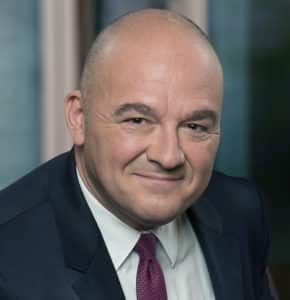
MJ Lytle, one of the founding partners of exchange-traded fund provider Source, is launching a new firm as pan-European exchange Euronext aims to provide a new ETF trading venue in the second half of this year.
Tabula Investment Management is planning to launch a range of fixed income ETFs targeting European institutional investors before the summer, subject to regulatory approval. Lytle, chief executive of Tabula, told Markets Media that although there are already more than 400 fixed income ETFs in Europe, half of these assets are concentrated in the top 20 funds.

MJ Lytle, Tabula Investment Management
Lytle said: “There is room for innovation in fixed income ETFs as the existing products are very similar to one another. So there is no reason for investors not to buy the largest ETF.”
Investors following standard fixed income indexes gain exposure to the companies with the largest amount of debt. However, Lytle said ETF issuers have not developed equal-weight indices.
“It is difficult to execute the underlying structure as investors buy bonds and hold them to maturity and it can also be difficult to buy enough bonds in a new issue,” he explained.
Tabula is also aiming to develop “pure” credit products which create exposure to healthy companies without exposure to the interest rate cycle.
Lytle added there are only 10 fixed income ETF providers in Europe with more than a modicum of assets and BlackRock’s iShares is dominant, managing 70% of the market. “The number ten provider in fixed income ETFs has assets of $300m so we can reach the top ten pretty quickly,” he said.
He was one of the founding partners of independent European ETF provider Source, which was acquired by US asset manager Invesco in April last year from Warburg Pincus. The private equity firm had purchased the ETF provider in 2014 and the three co-founders of Source subsequently left.
Source had launched in April 2009 and managed its own ETFs, as well as forming partnerships with other asset managers and distributing their ETFs on its platform. At the time of its acquisition by Invesco, Source had approximately $18bn in Source-managed assets and $7bn in externally managed assets.
Lytle said Tabula may adopt the same strategy. He added: “All opportunities are on the table.”
A survey by Tabula said there were record inflows of $140bn into fixed income ETFs last year. The study found that more than half, 53%, of investors believe 2018 will be a record year for inflows into fixed income ETFs. In addition 51% predicted there will be $1.6 trillion or more in fixed income ETFs by 2020, up from $600bn in 2016.
Consultancy Greenwich Associates said in a new report, European Institutions Explore New Asset Classes with ETFs, that average ETF allocations among institutions increased to 10.3 % of total assets last year, from just 7.7% in 2016.
*New* European Institutions Explore New Asset Classes with ETFs https://t.co/qXKZrMd1Ov via @GreenwichAssoc by #AndrewMcCollum #ETFs pic.twitter.com/IqKB9HccHN
— Greenwich Associates (@GreenwichAssoc) May 15, 2018
Andrew McCollum, managing director, said in the report that growth reflects the continuing adoption of ETFs into institutional portfolios as a standard means of obtaining beta exposures and the introduction of ETFs to a long list of portfolio functions, both strategic and tactical.
“Much of the growth over the past year can be attributed to the entry of new institutional users to the ETF market – especially in fixed income,” said McCollum. “The share of study participants investing in fixed-income ETFs increased to 45% in 2017 from 38% in 2016.”
One quarter of existing fixed-income ETF users are planning to increase allocations in the year ahead and most expect to boost allocations by 5% or more. About one fifth of respondents plan to boost allocations to fixed-income ETFs by 10% or more.
The co-head of fixed-income portfolio management for a U.K. asset manager swap in the Greenwich report: “Our principal use of ETFs is to displace cash bonds and access corporate bond market beta.”
The use of ETFs has also been boosted by concerns about fixed income liquidity, particularly in times of market stress.
The director of finance for an Italian insurance company said in the report: “At a time of high volatility in financial markets, January – February 2013, some portfolios that had ETF holdings allowed for a quick selloff and were faster at exiting the market.”
McCollum added that ETFs are spreading into asset classes outside equities and fixed income with one-third of respondents investing in commodity ETFs last year, up from one fifth in 2016. Greenwich interviewed 125 institutional investors between October and December last year for its fourth annual European ETF study.
Euronext is targeting ETFs through its acquisition of the Irish Stock Exchange, which closed in March this year. Euronext Dublin will be the group’s centre of excellence for ETFs and debt & funds listings. Deirdre Somers, chief executive of Euronext Dublin will join the group’s managing board and be responsible for developing both the Irish equity market and the centre of excellence.

Stéphane Boujnah, Euronext
Stéphane Boujnah, chief executive and chairman of Euronext, said on the exchange’s first quarter results call this morning that there are significant growth opportunities for the combined group through diversification of its revenues.
“Dublin can become the European ETF listing venue of choice for investors globally, providing an easy single entry point to Europe and a pan-European trading platform through its new multilateral trading facility, ETF Access, which will be launched in the second half of 2018,” added Boujnah.
A total of 796 ETFs were listed on Euronext was 796 at end of the first quarter. Euronext reported that on-exchange trading volumes rose by nearly one third year-on-year and the average daily transaction value on the electronic order book was €335m.
Tabula is working with consultant KB Associates to support the establishment of ETFs in Ireland; with HSBC to service the new funds; IHS Markit who will provide benchmark credit default swap indices; exchange ICE and PwC.
Cian Burke, global head of HSBC Securities Services, said in a statement: “ETFs continue to play a large part of the growth in the European investment fund industry. Ireland is central to this development and we have worked very hard to ensure we are leaders in this space.”
Lytle continued that there were three elements to Source’s success – good products on an operational basis, choosing the right exposures and understanding distribution.“Tabula has good partners so we are very credible,” he added.






